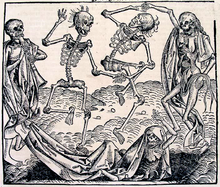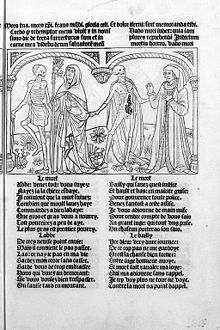- Danse Macabre
-
"Dance of Death" redirects here. For other uses, see Dance of Death (disambiguation).See also: Danse Macabre (disambiguation) and Dance of the Dead (disambiguation)
Dance of Death, also variously called Danse Macabre (French), Danza de la Muerte (Spanish), Dansa de la Mort (Catalan), Danza Macabra (Italian), Dança da Morte (Portuguese), Totentanz (German), Dodendans (Dutch), is an artistic genre of late-medieval allegory on the universality of death: no matter one's station in life, the Dance of Death unites all. The Danse Macabre consists of the dead or personified Death summoning representatives from all walks of life to dance along to the grave, typically with a pope, emperor, king, child, and labourer. They were produced to remind people of the fragility of their lives and how vain were the glories of earthly life.[1] Its origins are postulated from illustrated sermon texts; the earliest recorded visual scheme was a now lost mural in the Saints Innocents Cemetery in Paris dating from 1424-25.
Contents
Paintings
 Pieter Brueghel the Elder, The Triumph of Death (c. 1562) in the Museo del Prado, Madrid. Brueghel was strongly influenced by the style of Hieronymus Bosch.
Pieter Brueghel the Elder, The Triumph of Death (c. 1562) in the Museo del Prado, Madrid. Brueghel was strongly influenced by the style of Hieronymus Bosch.
The earliest recorded visual example is from the cemetery of the Church of the Holy Innocents in Paris (1424–25). There were also painted schemes in Basel (the earliest dating from c.1440); a series of paintings on canvas by Bernt Notke, in Lübeck (1463); the painting at the back wall of the chapel of Sv. Marija na Škrilinama in the Istrian town of Beram (1471), painted by Vincent from Kastav; and woodcuts designed in the early 1520s by Hans Holbein the Younger and executed by Hans Lützelburger (published 1538).
The deathly horrors of the 14th century—such as recurring famines; the Hundred Years' War in France; and, most of all, the Black Death—were culturally assimilated throughout Europe. The omnipresent possibility of sudden and painful death increased the religious desire for penitence, but it also evoked a hysterical desire for amusement while still possible; a last dance as cold comfort. The danse macabre combines both desires: in many ways similar to the mediaeval mystery plays, the dance-with-death allegory was originally a didactic dialogue poem to remind people of the inevitability of death and to advise them strongly to be prepared at all times for death (see memento mori and Ars moriendi).
Short verse dialogues between Death and each of its victims, which could have been performed as plays, can be found in the direct aftermath of the Black Death in Germany (where it was known as the Totentanz, and in Spain as la Danza de la Muerte). The French term danse macabre may derive from the Latin Chorea Machabæorum, literally "dance of the Maccabees."[2][3] In 2 Maccabees, a deuterocanonical book of the Bible, the grim martyrdom of a mother and her seven sons is described, and was a well-known mediaeval subject. It is possible that the Maccabean Martyrs were commemorated in some early French plays or that people just associated the book’s vivid descriptions of the martyrdom with the interaction between Death and its prey. An alternative explanation is that the term entered France via Spain, the Arabic word maqabir (cemetery) being the root of the word. Both the dialogues and the evolving paintings were ostensive penitential lessons that even illiterate people (who were the overwhelming majority) could understand.
 Danse macabre in St Maria in Bienno.
Danse macabre in St Maria in Bienno.
Furthermore, frescoes and murals dealing with death had a long tradition and were widespread, e.g. the legend of the Three Living and the Three Dead: on a ride or hunt, three young gentlemen meet three cadavers (sometimes described as their ancestors) who warn them, Quod fuimus, estis; quod sumus, vos eritis (What we were, you are; what we are, you will be). Numerous mural versions of that legend from the 13th century onwards have survived (for instance, in the hospital church of Wismar or the residential Longthorpe Tower outside Peterborough). Since they showed pictorial sequences of men and corpses covered with shrouds, those paintings are sometimes regarded as cultural precursors of the new genre.
A danse macabre painting may show a round dance headed by Death or a chain of alternating dead and live dancers. From the highest ranks of the mediaeval hierarchy (usually pope and emperor) descending to its lowest (beggar, peasant, and child), each mortal’s hand is taken by a skeleton or an extremely decayed body. The famous Totentanz in Lübeck’s Marienkirche (destroyed during the Allied Bombing of Lübeck in World War II) presented the dead dancers as very lively and agile, making the impression that they were actually dancing, whereas their living dancing partners looked clumsy and passive. The apparent class distinction in almost all of these paintings is completely neutralized by Death as the ultimate equalizer, so that a sociocritical element is subtly inherent to the whole genre. The Totentanz of Metnitz, for example, shows how a pope crowned with his mitre is being led into Hell by the dancing Death.
 Lübecker Totentanz by Bernt Notke (around 1463, destroyed in a bombing raid in 1942).
Lübecker Totentanz by Bernt Notke (around 1463, destroyed in a bombing raid in 1942).
Usually, a short dialogue is attached to each victim, in which Death is summoning him (or, more rarely, her) to dance and the summoned is moaning about impending death. In the first printed Totentanz textbook (Anon.: Vierzeiliger oberdeutscher Totentanz, Heidelberger Blockbuch, approx. 1460), Death addresses, for example, the emperor:
 Bernt Notke: Surmatants (Totentanz) in St. Nicholas' Church, Tallinn.
Bernt Notke: Surmatants (Totentanz) in St. Nicholas' Church, Tallinn.
- Emperor, your sword won’t help you out
- Sceptre and crown are worthless here
- I’ve taken you by the hand
- For you must come to my dance
At the lower end of the Totentanz, Death calls, for example, the peasant to dance, who answers:
- I had to work very much and very hard
- The sweat was running down my skin
- I’d like to escape death nonetheless
- But here I won’t have any luck
Printing
 The Abbot, woodcut from the Dance of Death series, 1523–26, 6.5 x 4.8 cm by Hans Holbein the Younger.
The Abbot, woodcut from the Dance of Death series, 1523–26, 6.5 x 4.8 cm by Hans Holbein the Younger.
The earliest known depiction of a print shop appears in a printed image of the Dance of Death, in 1499, in Lyon, by Mattias Huss. It depicts a compositor at his station, which is raised to facilitate his work, and a person running the press. To the right of the print shop, an early book store is shown. Early print shops were gathering places for the literati.
Musical settings
Musical examples include
- Mattasin oder Toden Tanz, 1598, by August Nörmiger
- Totentanz. Paraphrase on "Dies irae." by Franz Liszt, 1849, a set of variations based on the plainchant melody "Dies Irae".
- Danse Macabre by Camille Saint-Saëns, 1874
- Songs and Dances of Death, 1875–77, by Modest Mussorgsky
- Symphony No. 4, 2nd Movement, 1901, by Gustav Mahler
- Totentanz der Prinzipien, 1914, by Arnold Schoenberg
- The Green Table, 1932, ballet by Kurt Jooss
- "Scherzo (Dance of Death)," in Op. 14 Ballad of Heroes, 1939, by Benjamin Britten
- Piano Trio No. 2 in E minor, Op. 67, 4th movement, "Dance of Death," 1944, by Dmitri Shostakovich
- Der Kaiser von Atlantis, oder Die Tod-Verweigerung, 1944, by Viktor Ullmann and Peter Kien
- Poème macabre, 1963, composition for violin and piano by Eugen Suchoň with one part entitled "Danza macabre"
- The Dance of Death & Other Plantation Favorites, 1964, by John Fahey, includes the song "Dance of Death," a finger-style guitar solo in G minor tuning.
- Dance with Death, 1968, by Andrew Hill
- Black Angels, 1971, by George Crumb, with a danse macabre at the end of part one, "Departure."
- Dance of Death, 2003, by Iron Maiden
- Cantabile, 2nd movement "Cortège & Danse Macabre" (based on the poem "Cortège funèbre" (with the subtitle "Danse Macabre")), 2009, by Frederik Magle
- Danse macabre, 2011, by Gregory Rose
"Death and the Maiden" and other allusions
The motif "Death and the Maiden", is derived from the Danse Macabre, and has received numerous treatments in various mediums - most prominently Schubert's quartet of that name. Further developments of the motif include "Death and the Senator," "Death and the Compass," "Death and the King's Horseman," and "Death and the Daleks".
See also
- Death (Tarot card)
- La Calavera Catrina
- Macabre
- Skeleton (undead)
- The Seventh Seal
- Vanitas
- Black Death
Notes
References
- Israil Bercovici (1998) O sută de ani de teatru evriesc în România ("One hundred years of Yiddish/Jewish theater in Romania"), 2nd Romanian-language edition, revised and augmented by Constantin Măciucă. Editura Integral (an imprint of Editurile Universala), Bucharest. ISBN 973-98272-2-5.
- James M. Clark (1950) The Dance of Death in the Middle Ages and Renaissance.
- André Corvisier (1998) Les danses macabres, Presses Universitaires de France. ISBN 2-13-049495-1.
- Rolf Paul Dreier (2010) Der Totentanz - ein Motiv der kirchlichen Kunst als Projektionsfläche für profane Botschaften (1425-1650), Leiden, ISBN 978-90-902511-1-0 with CD-ROM: Verzeichnis der Totentänze, also on totentanz.nl
- Ann Tukey Harrison (1994), with a chapter by Sandra L. Hindman, The Danse Macabre of Women: Ms.fr. 995 of the Bibliothèque Nationale, Kent State University Press. ISBN 0-87338-473-3.
- Romania, National Library of ... - Illustrated Latin translation of the Danse macabre, late 15th century. treasure 4
- Marek Żukow-Karczewski, Taniec śmierci (Dance macabre), "Życie Literackie" ("Literary Life" - literary review magazine), 43/1989.
External links
- A collection of historical images of the Danse Macabre at Cornell's The Fantastic in Art and Fiction
- Holbein's Totentanz
Categories:- Dance in arts
- Death customs
- Caricature
- Medieval art
- Horror fiction
- Fantastic art
- Art genres
- Iconography
Wikimedia Foundation. 2010.


